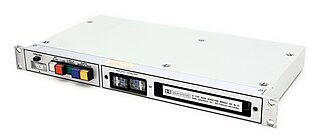Related Research Articles

A Dolby noise-reduction system, or Dolby NR, is one of a series of noise reduction systems developed by Dolby Laboratories for use in analog audio tape recording. The first was Dolby A, a professional broadband noise reduction system for recording studios in 1965, but the best-known is Dolby B, a sliding band system for the consumer market, which helped make high fidelity practical on cassette tapes, which used a relatively noisy tape size and speed. It is common on high-fidelity stereo tape players and recorders to the present day, although Dolby has as of 2016 ceased licensing the technology for new cassette decks. Of the noise reduction systems, Dolby A and Dolby SR were developed for professional use. Dolby B, C, and S were designed for the consumer market. Aside from Dolby HX, all the Dolby variants work by companding: compressing the dynamic range of the sound during recording, and expanding it during playback.

Freeview is the United Kingdom's sole digital terrestrial television platform. It is operated by Everyone TV and DTV Services Ltd, a joint venture between the BBC, ITV, Channel 4, Channel 5 and Sky. It was launched on 30 October 2002, taking over the licence from ITV Digital which collapsed that year. The service provides consumer access via an aerial to the seven DTT multiplexes covering the United Kingdom. As of July 2020, it has 85 TV channels, 26 digital radio channels, 10 HD channels, six text services, 11 streamed channels, and one interactive channel.

Digital Video Broadcasting (DVB) is a set of international open standards for digital television. DVB standards are maintained by the DVB Project, an international industry consortium, and are published by a Joint Technical Committee (JTC) of the European Telecommunications Standards Institute (ETSI), European Committee for Electrotechnical Standardization (CENELEC) and European Broadcasting Union (EBU).

Home cinema, also called home theaters or theater rooms, are home entertainment audio-visual systems that seek to reproduce a movie theater experience and mood using consumer electronics-grade video and audio equipment that is set up in a room or backyard of a private home. Some studies show that films are rated better and generate more intense emotions when watched in a movie theater, but convenience is a major appeal for home cinemas. In the 1980s, home cinemas typically consisted of a movie pre-recorded on a LaserDisc or VHS tape; a LaserDisc Player or VCR; and a heavy, bulky large-screen cathode ray tube TV set, although sometimes CRT projectors were used instead. In the 2000s, technological innovations in sound systems, video player equipment and TV screens and video projectors have changed the equipment used in home cinema set-ups and enabled home users to experience a higher-resolution screen image, improved sound quality and components that offer users more options. The development of Internet-based subscription services means that 2020s-era home theatre users do not have to commute to a video rental store as was common in the 1980s and 1990s.

Surround sound is a technique for enriching the fidelity and depth of sound reproduction by using multiple audio channels from speakers that surround the listener. Its first application was in movie theaters. Prior to surround sound, theater sound systems commonly had three screen channels of sound that played from three loudspeakers located in front of the audience. Surround sound adds one or more channels from loudspeakers to the side or behind the listener that are able to create the sensation of sound coming from any horizontal direction around the listener.

Dynamic range compression (DRC) or simply compression is an audio signal processing operation that reduces the volume of loud sounds or amplifies quiet sounds, thus reducing or compressing an audio signal's dynamic range. Compression is commonly used in sound recording and reproduction, broadcasting, live sound reinforcement and some instrument amplifiers.

dbx is a family of noise reduction systems developed by the company of the same name. The most common implementations are dbx Type I and dbx Type II for analog tape recording and, less commonly, vinyl LPs. A separate implementation, known as dbx-TV, is part of the MTS system used to provide stereo sound to North American and certain other TV systems. The company, dbx, Inc., was also involved with Dynamic Noise Reduction (DNR) systems.

Dolby Laboratories, Inc. is a British-American technology corporation specializing in audio noise reduction, audio encoding/compression, spatial audio, and HDR imaging. Dolby licenses its technologies to consumer electronics manufacturers.

In acoustics, loudness is the subjective perception of sound pressure. More formally, it is defined as the "attribute of auditory sensation in terms of which sounds can be ordered on a scale extending from quiet to loud". The relation of physical attributes of sound to perceived loudness consists of physical, physiological and psychological components. The study of apparent loudness is included in the topic of psychoacoustics and employs methods of psychophysics.

DTS, Inc. is an American company. DTS company makes multichannel audio technologies for film and video. Based in Calabasas, California, the company introduced its DTS technology in 1993 as a competitor to Dolby Laboratories, incorporating DTS in the film Jurassic Park (1993). The DTS product is used in surround sound formats for both commercial/theatrical and consumer-grade applications. It was known as The Digital Experience until 1995. DTS licenses its technologies to consumer electronics manufacturers.
Dolby Digital Plus, also known as Enhanced AC-3, is a digital audio compression scheme developed by Dolby Labs for the transport and storage of multi-channel digital audio. It is a successor to Dolby Digital (AC-3), and has a number of improvements over that codec, including support for a wider range of data rates, an increased channel count, and multi-program support, as well as additional tools (algorithms) for representing compressed data and counteracting artifacts. Whereas Dolby Digital (AC-3) supports up to five full-bandwidth audio channels at a maximum bitrate of 640 kbit/s, E-AC-3 supports up to 15 full-bandwidth audio channels at a maximum bitrate of 6.144 Mbit/s.
The Technology and Engineering Emmy Awards, or Technology and Engineering Emmys, are one of two sets of Emmy Awards that are presented for outstanding achievement in engineering development in the television industry. The Technology and Engineering Emmy Awards are presented by the National Academy of Television Arts and Sciences (NATAS), while the separate Primetime Engineering Emmy Awards are given by its sister organization the Academy of Television Arts & Sciences (ATAS).
MPEG Multichannel, also known as MPEG-2 Backwards Compatible, or MPEG-2 BC, is an extension to the MPEG-1 Layer II audio compression specification, as defined in the MPEG-2 Audio standard which allows it provide up to 5.1-channels of audio. To maintain backwards compatibility with the older 2-channel (stereo) audio specification, it uses a channel matrixing scheme, where the additional channels are mixed into the two backwards compatible channels. Extra information in the data stream contains signals to process extra channels from the matrix.
Dialnorm is the metadata parameter that controls playback gain within the Dolby Laboratories Dolby Digital (AC-3) audio compression system. Dialnorm stands for dialog normalization. Dialnorm is an integer value with range 1 to 31 corresponding to a playback gain of -30 to 0 dB (unity) respectively. Higher values afford more headroom and are appropriate for dynamic material such as an action film.
Telos Alliance is an American corporation manufacturing audio products primarily for broadcast stations. Headquartered in Cleveland, Ohio, US, the company is divided into six divisions:
The Commercial Advertisement Loudness Mitigation Act requires the U.S. Federal Communications Commission to bar the audio of TV commercials from being broadcast louder than the TV program material they accompany by requiring all "multichannel video programming" distributors to implement the "Techniques for Establishing and Maintaining Audio Loudness for Digital Television" issued by the international industry group Advanced Television Systems Committee. The final bill was passed on September 29, 2010.
EBU R 128 is a recommendation for loudness normalisation and maximum level of audio signals. It is primarily followed during audio mixing of television and radio programmes and adopted by broadcasters to measure and control programme loudness. It was first issued by the European Broadcasting Union in August 2010 and most recently revised in August 2020.
Loudness, K-weighted, relative to full scale (LKFS) is a standard loudness measurement unit used for audio normalization in broadcast television systems and other video and music streaming services.
The Digital Production Partnership (DPP) is an initiative formed jointly by the UK's public service broadcasters to help producers and broadcasters maximise the potential benefits of digital television production.
Dolby AC-4 is an audio compression technology developed by Dolby Laboratories. Dolby AC-4 bitstreams can contain audio channels and/or audio objects. Dolby AC-4 has been adopted by the DVB project and standardized by the ETSI.
References
- ↑ "DTSAC3". Archived from the original on 2010-02-27. Retrieved 2010-03-14. Retrieved April 11, 2013
- ↑ broadcastengineering.com http://broadcastengineering.com/blog/linear-acoustic-founder-tim-carroll-share-expert-perspective-loudness-control-listener-fatigue- . Retrieved April 11, 2013.
{{cite web}}: Missing or empty|title=(help)[ title missing ] - ↑ LA Times CALM Act: Reducing TV commercial volume was a feat http://articles.latimes.com/2012/dec/13/entertainment/la-et-ct-calm-act-an-engineering-feat-20121213 Retrieved April 11, 2013
- ↑ What’s up with obnoxiously loud TV shows and commercials? June 1, 2012 Retrieved April 11, 2013 http://www.straightdope.com/columns/read/3055/what-s-up-with-obnoxiously-loud-tv-shows-and-commercials
- ↑ Eshoo, Whitehouse & Industry Leaders Trumpet New Law to Stop High Volume Commercials Dec. 13 2012 http://eshoo.house.gov/index.php?option=com_content&task=view&id=1294&Itemid=100067 Retrieved April 11, 2013
- ↑ Linear Acoustic AERO
- ↑ Linear Acoustic to Provide UPMAX:neo(TM) 5.1 Channel Upmixer, June 23, 2008, retrieved April 11, 2013
- ↑ "Linear Acoustic Provides AERO.qc Audio Quality Controllers For NBC's Coverage Of The Vancouver Winter Games", Broadcast Engineering, March 12, 2010, retrieved April 11, 2013
- ↑ "Linear Acoustic and Dolby Expand Partnership", NAB Daily News, April 17, 2012, retrieved April 16, 2013
- ↑ "Linear Acoustic honored with Technical EMMY for real-time audio/metadata processor", Broadcast Engineering, February 3, 2011, retrieved April 11, 2013